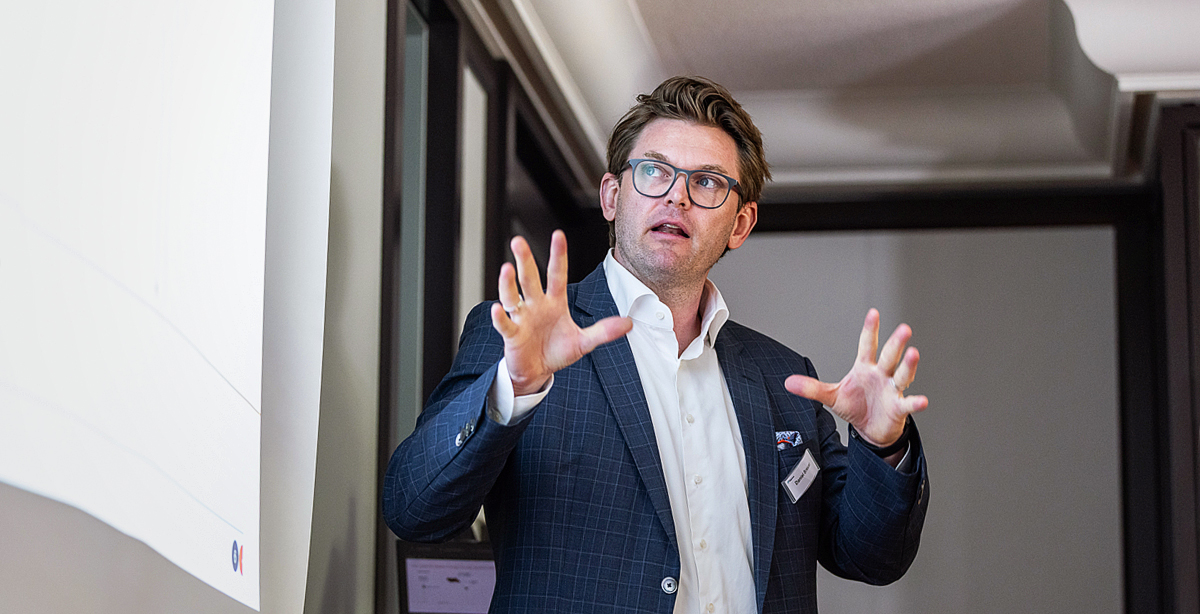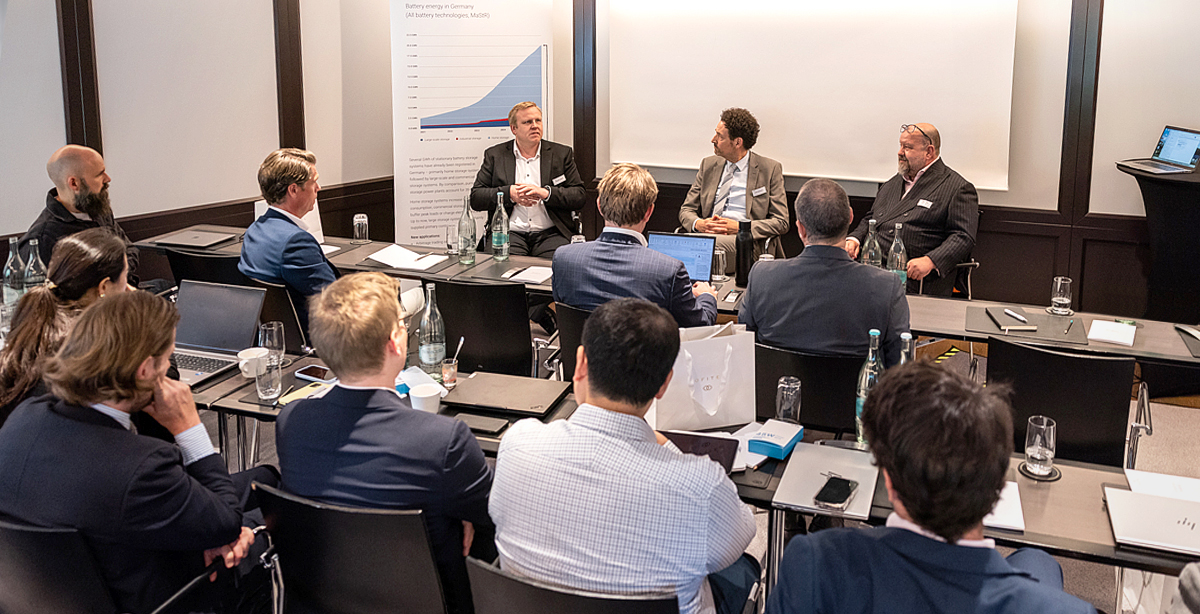First Investor Day – fully charged with BESS insights, July 1 2025 at the Sofitel Frankfurt Opera
Charged with Insight and Opportunity
On July 1, energy investors, lenders, market innovators, and legal experts convened at the Sofitel Frankfurt Opera for Repono’s first-ever Banker’s Day. The theme was clear: Battery Energy Storage Systems (BESS) are no longer a fringe play in Europe’s energy transition—they’re at the center. And as the continent doubles down on renewables, the spotlight is turning sharply toward storage as the bridge to grid reliability and market flexibility.
Combining extensive market analysis, regulatory clarity, technological insight, and frank dialogue about risk, returns, and the realities of execution, the event brought together leading voices from Repono, Aurora Energy Research, Enspired, and Osborne Clarke, as well as an expert panel featuring technical operators, sponsors, and financiers. It was, as one participant put it, “a rare day where you get this much practical insight and strategic clarity all in one room.”
Why Storage, Why Now?
The intermittency of renewables is no longer just a technical challenge—it’s an economic one. Germany, for instance, is seeing an explosion in negative pricing hours, even as it phases out coal. BESS are uniquely positioned to stabilize the grid, arbitrage price swings, and provide critical grid services.
As Europe accelerates its renewable rollout, the question of how to make large-scale energy storage commercially viable and how to accelerate BESS deployment has become increasingly urgent. Spain’s recent blackouts and Germany’s increasingly erratic electricity prices are stark reminders of what’s at stake when grid flexibility doesn’t keep pace with deployment.

Market Intelligence: BESS in Germany and Europe
Opening the agenda, Oxford-based Aurora Energy Research took a deep dive into Germany’s BESS outlook. Their message was unequivocal: market fundamentals remain strong.
Germany could see 30 GW of battery capacity by 2030—a 15-fold increase. Even the most conservative forecasts suggest a quadrupling from today’s levels. That growth is fueled by surging price spreads, which have tripled since 2020.
“Today is a golden time for batteries,” the company’s principal Thaddäus Kreisig noted. “Spreads are high, the need for flexibility is urgent, and even with future revenue compression, battery storage remains a profitable play. The biggest barrier is securing a grid connection.”
Ancillary services (like aFRR and FCR) are important for grid stability and currently deliver strong returns. But these markets are small and risk saturation. Kreisig stressed that wholesale markets (day-ahead and intraday) will remain the long-term revenue backbone. Aurora’s modeling tool Chronos simulates multi-market optimization and forecasts strong business cases for 2- to 4-hour systems entering the market through 2029.

Trading and Technology: Showing the Art of Optimization
Where Aurora mapped the terrain, Enspired showed what it’s like to race on it.
The Vienna-based optimizer gave a candid look at how it uses real-time algorithmic trading to maximize revenue, reduce wear and tear, and extend battery life. Their approach isn’t theoretical—it’s audited by one of the Big four.
“Backtests are useful, but certified results are better,” Liam Armstrong, the company’s Senior Sales Expert noted. “We believe transparency should be the norm, not the exception.” Enspired is working with KPMG to review and endorse the results of their third-party optimizer services.
Enspired’s performance in live European markets has consistently outpaced traditional merchant models, thanks in part to their heavy use of virtual trading—allowing batteries to earn revenue without cycling.
Just as critical, the company emphasized the importance of smart warranty structuring. By reducing operational stress on assets, they’ve helped clients negotiate more favorable terms, sometimes unlocking better performance guarantees and longer warranties.
“We’re not just chasing short-term profit—we’re building battery business models that last 20 years and deliver value every day,” Armstrong concluded.

Legal Reality Check: Unpacking the Risk Landscape
Dr. Daniel Breuer of international law firm Osborne Clarke delivered a refreshingly blunt legal overview. While Germany has opened doors for battery storage with tax exemptions and regulatory incentives, serious roadblocks remain.
Permitting and grid connection processes remain inconsistent and unclear. The absence of prioritization rules (as seen in renewables) means battery developers are often left to navigate a DSO landscape with no standardization.
“If a DSO tells you, ‘I have too much wind and solar, I can’t connect a battery,’ that’s a failed job,” Breuer said. “We need basic literacy about storage within the system.”
He warned that changes to Germany’s grid fee structure (such as the incoming “AGNES” framework) could affect project viability after 2029 unless proactively addressed.
Still, there is progress. Legal structures around hybrid tolling, dynamic warranties, and virtual power plant models are maturing quickly. Breuer advised getting legal involved early, especially to ensure bankable warranties, enforceable EPC contracts, and tech tours that reflect actual system design:
“Warranties are no longer just technical details—they’re a cornerstone of financing.”

What Operators, Bankers and Investors Are Really Thinking
Closing out the day was a panel discussion featuring Repono CTO Greger Landén, Voltiq Co-founder Joost Samsom, and BESS financing expert Aziz Teksoy, tackling challenges from software failures to financing structures.
Among other things, the panel explored hybrid revenue models (e.g. 50% fixed, 50% merchant), current loan tenors (typically up to 12 years), margins (200–300 bps), and strategies for dynamic repayments via cash sweeps.
The consensus? Early movers with good design, strong partners, and credible counterparties still have a significant edge.
Stressing that software is the silent saboteur of uptime, Landén emphasized:
“The risk to uptime is not fire or failure—it’s firmware. We pass through 14 software layers to do a trade.”
Samsom, meanwhile, offered a clear-eyed view on the economics of early operating projects:
“If you can use merchant cash flow to build the asset and repay fast, you’ll own a highly competitive project in six years.”
Other lenders in the room echoed the logic: build early, repay fast, and structure for flexibility. One banker noted, “This is a first-mover’s market—you want to harvest the high spreads now, not wait for the system to catch up.”
What’s Next?
Striking a balance between vision and pragmatism, the message sent to investors eyeing the BESS sector was crystal clear: this is no longer a speculative market.
Battery storage is real, revenue-generating, and structurally needed in every European grid. But it’s not plug-and-play. The winners will be those who understand the mechanics—and the legal, technical, and financial nuance—of getting to COD and beyond.
Repono’s first Banker’s Day made one thing unmistakable: the future of energy isn’t just renewable—it’s stored, stable, and full of opportunity.
For those who missed the inaugural event, Repono will host its second Banker’s Day in mid-2026.



